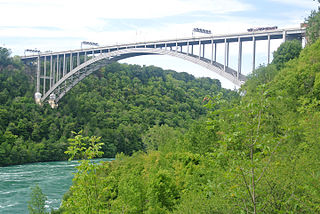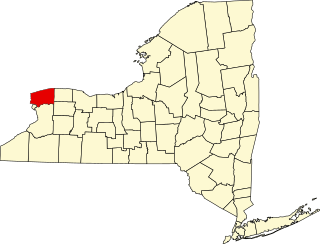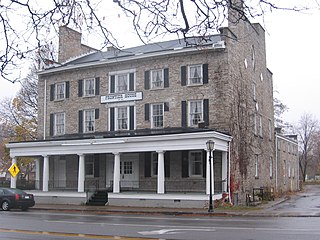
Niagara County is in the U.S. state of New York. As of the 2020 census, the population was 212,666. The county seat is Lockport. The county name is from the Iroquois word Onguiaahra; meaning the strait or thunder of waters.

Niagara Falls is a city in Niagara County, New York, United States. As of the 2020 census, the city had a total population of 48,671. It is adjacent to the Niagara River, across from the city of Niagara Falls, Ontario, and named after the famed Niagara Falls which they share. The city is within the Buffalo–Niagara Falls metropolitan area and the Western New York region.

Youngstown is a village in Niagara County, New York, United States. The population was 1,935 at the 2010 census. It is part of the Buffalo–Niagara Falls Metropolitan Statistical Area.

Lewiston is a village in Niagara County, New York, United States. The population was 2,701 at the 2010 census. The village is named after Morgan Lewis, an early 19th-century governor of New York. It is part of the Buffalo–Niagara Falls Metropolitan Statistical Area.

Lewiston is a town in Niagara County, New York, United States. The population was 15,944 at the 2020 census. The town and its contained village are named after Morgan Lewis, a governor of New York.

Fort Niagara, also known as Old Fort Niagara, is a fortification originally built by New France to protect its interests in North America, specifically control of access between the Niagara River and Lake Ontario, the easternmost of the Great Lakes. The fort is on the river's eastern bank at its mouth on Lake Ontario. Youngstown, New York, later developed nearby.

Queenston is a compact rural community and unincorporated place 5 kilometres (3.1 mi) north of Niagara Falls in the Town of Niagara-on-the-Lake, Ontario, Canada. It is bordered by Highway 405 to the south and the Niagara River to the east; its location at the eponymous Queenston Heights on the Niagara Escarpment led to the establishment of the Queenston Quarry in the area. Across the river and the Canada–US border is the village of Lewiston, New York. The Lewiston-Queenston Bridge links the two communities. This village is at the point where the Niagara River began eroding the Niagara Escarpment. During the ensuing 12,000 years the Falls cut an 11 kilometres (6.8 mi) long gorge in the Escarpment southward to its present-day position.

The Lewiston–Queenston Bridge, also known as the Queenston–Lewiston Bridge, is an arch bridge that crosses the Niagara River gorge just south of the Niagara Escarpment. The bridge was officially opened on November 1, 1962. It is an international bridge between the United States and Canada. It connects Interstate 190 in the town of Lewiston, New York to Highway 405 in the community of Queenston, Ontario. The Lewiston–Queenston Bridge is a twin of the Rainbow Bridge at Niagara Falls and designed by Richard Lee.
Earl W. Brydges Artpark State Park is a 108-acre (0.44 km2) state park located in the Village of Lewiston in Niagara County, New York. The park, which is officially named after former New York State Senator Earl Brydges, is generally referred to as Artpark.

The Embassy of the United States of America in Ottawa is the diplomatic mission of the United States of America to Canada. Opened in 1999, the embassy complex is located at 490 Sussex Drive in Ottawa, Ontario.

Chappaqua station is a commuter rail stop on the Metro-North Railroad's Harlem Line, located in Chappaqua, New York, United States, within the town of New Castle.

Raritan Landing is a historical unincorporated community located within Piscataway Township in Middlesex County, in the U.S. state of New Jersey, which was once an inland port, the farthest upstream point ocean-going ships could reach along the Raritan River, across from New Brunswick. Begun in the early 18th century it remained vital until the mid 19th century, when most of the port was abandoned.

This is a list of the National Register of Historic Places listings in Erie County, New York.

Mount St. Mary's Hospital or St. Mary's Manor is a historic Neoclassical Revival hospital building located at Niagara Falls in Niagara County, New York. It was listed on the National Register of Historic Places in 2015.

Frontier House is considered the "crown jewel" of Lewiston's historic district and one of the most historic landmarks in Western New York. In the early 1800s it was known as the finest hotel in America, west of Albany. It has been home to several Niagara County businessmen and honored guests. The building has been on the National Register of Historic Places listings in Niagara County, New York since 1974. It has served as a hotel, private home, a fine dining restaurant, museum, and a fast food establishment (McDonald's). It is found in Western New York, about ten minutes from Niagara Falls.

Lewiston Mound is a prehistoric burial mound built by the indigenous peoples of the Hopewell tradition. It is located on the grounds of the Earl W. Brydges Artpark State Park, at Lewiston in Niagara County, New York.
This is a list of the National Register of Historic Places listings in Niagara Falls, New York.
Louis-Thomas Chabert de Joncaire, also known as Sononchiez by the Iroquois, was a French army officer and interpreter for New France who worked with the Iroquois tribes during the French and Indian Wars in the early 18th century. He helped negotiate the Great Peace of Montreal in 1701 and founded Fort Niagara in 1720.


















